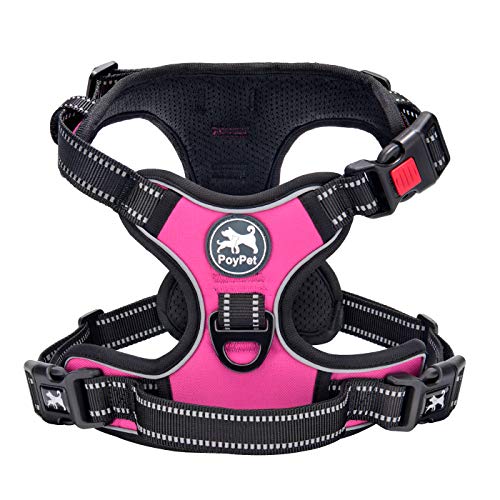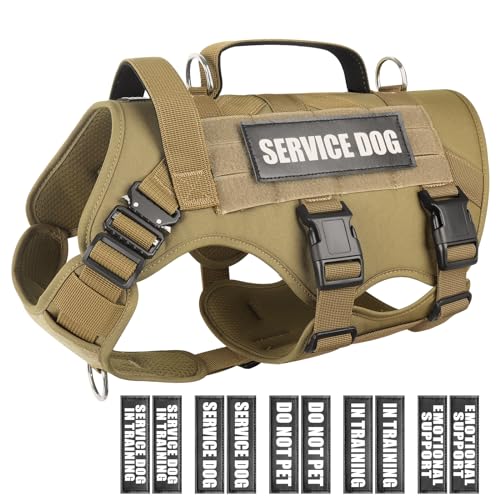
Bark and collar
A bark collar is a device used to discourage excessive barking in dogs. It emits a sound, vibration, or mild correction. Proper training and consideration of your dog’s personality are important. Choose the right collar, ensure proper fit, and use it responsibly and ethically.
Dog Collars, harnesses, and leashes are important tools for keeping your dog safe and under control while walking or traveling. There are many different types of collars, harnesses, and leashes available, so it’s important to choose the right one for your dog’s size, temperament, and needs.
Collars
Collars are typically used to hold identification tags and to attach a leash for walking. They come in different materials, such as leather, nylon, or metal chain. Some collars are designed to help prevent pulling or to keep dogs from slipping out of them. It’s important to choose a collar that fits your dog comfortably and that is not too tight or too loose.
Harnesses
Harnesses are another option for controlling your dog while walking. They fit around the dog’s chest and torso, rather than around the neck like a collar. Harnesses are a good choice for dogs that have respiratory issues or that tend to pull on their leash. There are different types of harnesses, such as front-clip, back-clip, or no-pull harnesses, so it’s important to choose the right one for your dog’s needs.
Leashes
Leashes are used to control your dog’s movements while walking or traveling. They come in different lengths and materials, such as leather, nylon, or retractable. It’s important to choose a leash that is appropriate for your dog’s size and strength. A short leash is best for training or walking in crowded areas, while a longer leash is better for allowing your dog more freedom to explore.
Overall, choosing the right collar, harness, and leash for your dog is important for their safety and comfort while walking or traveling. Be sure to measure your dog’s neck and chest before purchasing a collar or harness, and choose a leash that is appropriate for your dog’s size and strength.
- Subscription required for each device. #1 Best Selling for 3 years. USA made Tech. Unlimited distance real time tracking 4G LTE +3 Bands. Full USA & worldwide coverage. International SIM card included. USA based company focused in GPS tracking. Our competition are just white label resellers. Our clients to name a few, are cellular Giant Vodafone & UPS. Track Vehicles, Cars, trucks, Children, ATV, assets. For each device a monthly fee of 19.95USD is required or as low as 9.95USD for long term plan
- Smallest & lightest 1.8×1.6x 0.7in & only 1.26 oz. Combined 4G+3G+2G technology, best coverage as opposed to trackers with only 4G connection. In USA requires AT&T or T-Mobile coverage. Includes: Strong Magnet, Waterproof Silicone Cover, Belt Clip, Key Ring & Lanyard Use as gps tracker for trailers, luggage GPS tracker, key tracker, car tracker devices. The tracker features up to 5-years location history We believe the customer is king and offer live customer support 24/7 phone and chat.
- Rechargeable battery lasts up to 2-5 days (depending on tracking mode) with real time tracking updates at 1-5min intervals and up to 60 days with 1-3 tracking updates p/day (battery saver mode). Optional 3,500mAh battery+magnetic waterproof box available providing x6 longer battery life: 3-4 weeks at 1min update and up to 10 months in battery saver mode (Search item B07YVNV82V). Use as GPS tracker for luggage, GPS tracker for kids, asset GPS tracker, vehicle tracker.
- Tracking technology uses GPS primarily and Wi-Fi & GSM as a secondary backup. Tracki scans for nearby WiFi routers for accurate location when GPS is unavailable. View live tracking on the map, set real-time alerts when device crosses a geo-fence zone you preset when used as gps tracking device for car, tracking device for children or valuables. Receive SOS, low-battery, speed & movement alerts via push notification, email or (optional) SMS. Use as a cars tracker, GPS tracker for vehicles, kids GPS tracker
- Our lifetime warranty covers lost or damaged devices. Tracki is cutting-edge, easy to set up and works right out-of-the-box within minutes without meddling with car & vehicle electronics. Use as a tracking device for cars, boat GPS tracker, bike tracker and more. Tracki’s highly-rated dedicated mobile and web app is compatible with: Android, iOS and all web browsers (IOS 13 and up, Android 6 and up). Includes magnet attachment for GPS tracker car and waterproof silicone cover. gps para carros escondidos
Collar and Comb
Dog Harnesses
Dog Leashes
Comb and Collar Dog Grooming
Comb and collar dog grooming is a common practice to keep your dog’s coat healthy and shiny. Combing helps to remove tangles and mats, while collars serve as a way to control your dog and attach a leash for walks.
Comb and Dog Grooming
When choosing a comb for your dog, it’s important to consider the type of coat your dog has. A slicker brush or rake comb is best for dogs with long or thick fur, while a bristle brush is better for short-haired breeds.
For collars, it’s important to choose one that fits properly and is comfortable for your dog. Make sure it’s not too tight, but not too loose that your dog can slip out of it. Harnesses are also a good option, especially for dogs that tend to pull on their leash or have respiratory issues.
Regular grooming with a comb and collar can also help to keep your dog’s skin healthy and reduce shedding. Just be sure to use gentle strokes and avoid tugging on any knots or mats.
Tactical Dog Harness
Puppy Hates Collar
If your puppy hates wearing a collar, there are a few things you can do to help them get used to it. First, start by introducing the collar gradually. Let your puppy sniff and investigate the collar before trying to put it on. Once they are comfortable with the collar, try putting it on for short periods of time and gradually increase the length of time they wear it.
You can also try positive reinforcement training by giving your puppy treats or praise when they wear the collar without fussing. Make sure the collar is properly fitted and not too tight, as this can cause discomfort and make your puppy less willing to wear it.
Another option is to try a different type of collar, such as a harness or a soft fabric collar, to see if your puppy is more comfortable with that style. Keep in mind that some puppies may simply take longer to get used to wearing a collar, so patience and consistency are key. If your puppy continues to resist wearing a collar, consult with a veterinarian or a professional dog trainer for additional guidance.
- [3 Safe Modes Training Collar] Featuring 3 safe modes: Beep, Vibrate and Shock, shock collar enables you to set the right stimulation levels for your pet, which is helpful in deterring dogs from undesirable habits.
- [Security Lock & 1600ft Remote] The security keypad lock can significantly prevent accidental pushes while carrying the remote. The remote has a range of up to 1600ft, making it easy to train your dog indoors or outdoors.
- [Waterproof Receiver & Comfortable Collar] The IPX7 waterproof collar is convenient for dogs playing around a pool or in the rain freely. The e collar strap length can be adjusted, fitting dogs weighing over 10 pounds with neck measurements ranging from 8 to 24.4 inches!
- [Easy to Use & 4 Channel] The large buttons and clear digital screen make it easy to operate the shock collar for large dogs during day or night. Besides, it has memory function for settings and can train up to 4 dogs without resetting it.
- [Quick Charging & Long Lasting Battery] After fully recharged within 2 hours by phone adapter and USB outlet of the PC/power bank/car, the dog collar can last up to 35 days of standby time and the remote 45 days. Note: Don’t charge with the adapter whose power is greater than 5V1A.
Dog Collars, Harnesses & Leashes Frequently Asked Questions
Is it better to walk a dog with a harness or collar?
Both collars and harnesses have their advantages and disadvantages when it comes to walking a dog. Here are some things to consider:
Collars:
– Easier to put on and take off
– More common and readily available
– May be more comfortable for dogs with short hair
– Can be used for identification purposes (e.g. tags with owner information)
Harnesses:
– Can be more comfortable for dogs with neck or respiratory problems
– Provide better control and less risk of injury to the neck
– Discourage pulling behavior more effectively
– May be more secure for dogs that tend to slip out of collars
Ultimately, the decision between a collar and harness depends on your dog’s individual needs and behavior. It’s important to choose a collar or harness that fits properly and doesn’t cause discomfort or injury to your dog. Consult with your veterinarian or a professional dog trainer for guidance on what type of equipment is best for your dog.
Should a dog wear a collar with a harness?
It’s important for dogs to wear a collar with identification tags even when wearing a harness. The collar and tags allow for easy identification if the dog gets lost. The harness is used for control during walks and to prevent choking or neck strain. It is important to ensure that the collar is not too tight and does not interfere with the fit of the harness.
Is a harness better for a dog than a collar?
Yes, a harness is often considered better for dogs than a collar. Unlike collars, which can put pressure on a dog’s neck and throat, harnesses distribute the force evenly across the chest and shoulders, reducing the risk of injury or choking. Additionally, harnesses can provide more control over a dog’s movements, making them a safer and more comfortable option for walking and training. It’s essential to choose the right size and type of harness that suits your dog’s needs and ensures a secure fit for optimal benefits.
Do vets recommend harnesses?
Yes, many veterinarians do recommend using harnesses for dogs, especially in certain situations. Harnesses are often preferred over collars, especially for dogs with respiratory issues, small breeds, or brachycephalic breeds (short-nosed breeds). Harnesses can be gentler on a dog’s neck and throat, reducing the risk of injury or discomfort.
For dogs that have a tendency to pull on the leash during walks, a front-clip harness can offer better control and help discourage pulling behavior. Additionally, for dogs with certain medical conditions or neck injuries, a harness can be a safer alternative to a collar.
However, every dog is unique, and there may be instances where a collar is more suitable based on the dog’s specific needs and behavior. It’s always best to consult with a veterinarian or a professional dog trainer to determine the most appropriate choice for your individual dog.
Do vets recommend dog collars?
Yes, veterinarians do recommend dog collars in many cases. Collars serve various purposes and can be essential for identification, as they typically have a place to attach ID tags with the dog’s name and contact information.
Additionally, regular flat collars are suitable for most dogs and are commonly used for everyday activities, such as walking and hanging a leash. For well-behaved dogs that do not pull excessively on the leash, a collar can be a simple and convenient option.
However, as mentioned earlier, there are situations where a harness might be more suitable, such as for dogs with certain health issues or breeds prone to respiratory problems. It’s essential to consider your dog’s individual needs and behavior when choosing between a collar and a harness.
Ultimately, veterinarians take into account factors such as the dog’s size, breed, age, and any medical conditions when recommending the most appropriate collar or harness for each specific case.
Do dogs like wearing collars all the time?
Whether dogs like wearing collars all the time can vary depending on the individual dog and their experiences with collars. Some dogs are perfectly fine wearing collars and may not show any signs of discomfort or distress. They may become accustomed to wearing a collar from a young age and associate it with positive experiences, such as going for walks or receiving treats.
On the other hand, some dogs may not enjoy wearing collars, especially if they have not been properly introduced to them or have had negative experiences associated with wearing one. They may try to scratch or paw at the collar, attempt to remove it, or display signs of anxiety or stress.
If you notice that your dog is showing signs of discomfort or stress when wearing a collar, it’s essential to address the issue. You can try introducing the collar gradually in a positive and rewarding manner, associate it with pleasant experiences, and ensure that it fits comfortably. Alternatively, you might consider using a harness if your dog seems more comfortable with that option.
Always observe your dog’s behavior and seek the advice of a veterinarian or professional dog trainer if you have concerns about your dog’s comfort or well-being with regard to wearing a collar.
Should dogs sleep with their collars on?
Whether dogs should sleep with their collars on is a matter of personal preference and safety considerations. There is no hard and fast rule, and it ultimately depends on the specific circumstances and individual dog.
Some pet owners prefer to remove their dog’s collar at night to allow their pet’s neck to have a break from any potential pressure or irritation that the collar might cause. This can be especially true for dogs with sensitive skin or those prone to developing collar-related issues like matting of the fur around the neck.
On the other hand, some pet owners feel more secure having their dog wear a collar even during sleep, as it ensures their dog is always identifiable in case they accidentally escape or get lost.
If you choose to leave your dog’s collar on during sleep, it’s essential to use a well-fitted collar that doesn’t cause discomfort or restrict breathing. Quick-release or breakaway collars can be safer options, as they are designed to come undone easily if the collar gets caught on something, reducing the risk of choking or injury.
Ultimately, the decision of whether to let your dog sleep with a collar on or not is up to you, but it’s essential to consider your dog’s comfort and safety when making that choice. If you have any concerns or if your dog shows signs of discomfort, consult with a veterinarian or consider using a harness instead.





](https://m.media-amazon.com/images/I/41ji4lsxEIL.jpg)
















